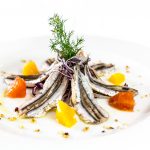Small fish, big health benefits: Is it time to rethink anchovies?
 (NaturalHealth365) Why is it that most of the world’s anchovies aren’t destined for the dinner plate but processed into fishmeal and oil for use in animal feeds, food additives, and fertilizers? At best, anchovies have a mixed reputation in the U.S., where most consumers rather eat a tender filet of salmon, cod, or haddock, even if – as is the case with salmon – four-fifths of the fish consumed in the U.S. is farm-raised. But here’s the thing about anchovies: the small, bite-sized fish are a superfood that can greatly impact human health and cognitive development.
(NaturalHealth365) Why is it that most of the world’s anchovies aren’t destined for the dinner plate but processed into fishmeal and oil for use in animal feeds, food additives, and fertilizers? At best, anchovies have a mixed reputation in the U.S., where most consumers rather eat a tender filet of salmon, cod, or haddock, even if – as is the case with salmon – four-fifths of the fish consumed in the U.S. is farm-raised. But here’s the thing about anchovies: the small, bite-sized fish are a superfood that can greatly impact human health and cognitive development.
According to Shakuntala Thilsted, winner of the 2021 World Food Prize, anchovies can fight malnutrition, prevent stunting, and promote cognitive development in children. They are good for pregnant women, as small fish have a shorter lifespan than large fish and have less chance of concentrating heavy metal contaminants. Moreover, a 100g serving of anchovies can provide us with 19 grams of protein, 77 grams of calcium, 3 milligrams of iron, and plenty of omega-3s. Anchovies are also a rich source of the B vitamins niacin, riboflavin, and vitamin B-12.
Don’t be fishy about the anchovy: It’s time to reconsider it as a tiny powerhouse of nutrition
Ask most Americans what they think of anchovies, and chances are they’ll wrinkle their noses. Maybe … maybe they’ll consent to have some scattered on a Caesar Salad or atop a pizza. Still, most hungry consumers have the same opinion as Ninja Turtle Michelangelo: “Oh, and I want no anchovies. And I mean, no anchovies. You put anchovies on this thing, and you’re in big trouble, okay?!”
Still, while the little fish are mostly maligned in the U.S., they’ve been happily devoured around the world for centuries. The ancient Greeks prized the little fish, the Romans turned them into garum, and almost every Asian country has its own unique anchovy sauce.
The health benefits aren’t the only reason to reconsider anchovies
Consuming less fish at the top of the food chain helps re-balance the marine ecosystem.
According to a study by Villy Christensen of the University Of British Columbia’s Fisheries Center, populations of predator fish at the top of the food chain, such as cod, tuna, and groupers, have suffered huge declines, shrinking by around two-thirds in the past 100 years. However, populations of “forage fish,” such as anchovy, sardines, and capelin, have more than doubled over the past century.
Anchovy has a short life span and reproduces quickly and is, therefore, a more sustainable option than other fish.
What’s the most nutritious way to eat anchovies?
Cooking and eating the fish whole is the easiest way to prepare anchovies. However, according to Shakuntala Thilsted, converting the fish into a fish powder with mortar and pestle is “extremely powerful because you are removing the moisture content and concentrating the nutrients by a factor of four.” Making a fish chutney is also an option.
Good anchovies are soft, creamy, sweet, and savory – a perfect expression of the fifth taste: unami. It’s a small fish with big health benefits, and American consumers should reconsider adding it to their diet.
Sources for this article include:



